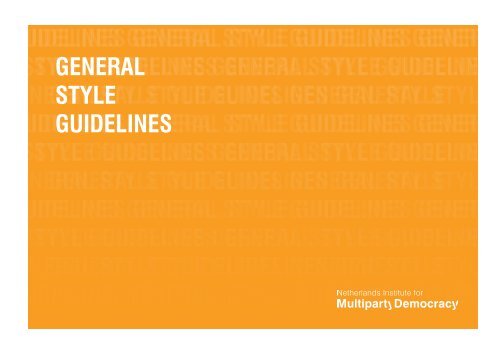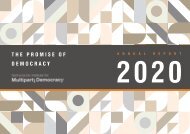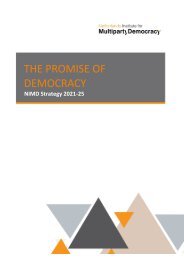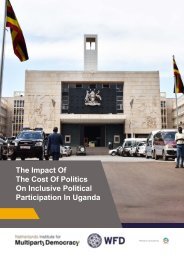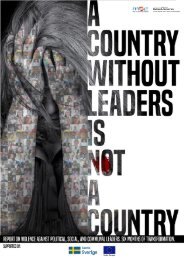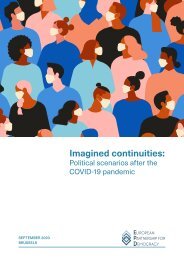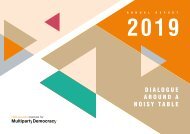NIMD Style Guidelines
Create successful ePaper yourself
Turn your PDF publications into a flip-book with our unique Google optimized e-Paper software.
GENERAL GENERAL STYLE STYLE GUIDELINES GENERAL GENERAL STYLE STYLE<br />
GUIDELINES GENERAL STYLE GUIDELINES GENER-<br />
AL L STYLE GENERAL GUIDELINES GENERAL STYLE GUIDELINES<br />
GENERAL GENERAL STYLE STYLE STYLE GUIDELINES GENERAL GENERAL STYLE STYLE<br />
GUIDELINES<br />
GENERAL STYLE GUIDELINES GENER-<br />
AL L STYLE GUIDELINES GENERAL STYLE GUIDELINES<br />
GENERAL GENERAL STYLE STYLE GUIDELINES GENERAL GENERAL STYLE STYLE<br />
GUIDELINES GENERAL STYLE GUIDELINES GENER-<br />
AL L STYLE GUIDELINES GENERAL STYLE GUIDELINES<br />
GENERAL GENERAL STYLE STYLE GUIDELINES GENERAL GENERAL STYLE STYLE<br />
GUIDELINES GENERAL STYLE GUIDELINES GENER-<br />
AL L STYLE GUIDELINES GENERAL STYLE GUIDELINES
INTRODUCTION<br />
This document contains guidelines on how to apply the visual identity of <strong>NIMD</strong>.<br />
It is divided into three sections:<br />
• a section with the general style guidelines;<br />
• a writing guide;<br />
• an annex with technical specifications.<br />
The first and second section are designed for <strong>NIMD</strong> staff and implementing partners.<br />
They can use this document to brief their communication agencies and approve and<br />
monitor communication activities in their countries.<br />
The annex is specifically for the designers and communication agencies. It provides all the<br />
technical details on the use of <strong>NIMD</strong>’s style elements.<br />
WHEN A VISUAL<br />
IDENTITY IS PRESENTED<br />
CONSISTENTLY, IT<br />
CREATES A POSITIVE AND<br />
LASTING IMPRESSION OF<br />
THE ORGANIZATION.<br />
All style elements can be downloaded from the <strong>Style</strong> Guide website:<br />
www.nimd.org/<strong>Style</strong>Guide<br />
This <strong>Style</strong> Guide ensures that everyone within <strong>NIMD</strong> – from <strong>NIMD</strong> Headquarters (HQ) in<br />
The Hague to country offices and implementing partner organizations – represents <strong>NIMD</strong><br />
in the same way.<br />
For questions about the <strong>Style</strong> Guide or specific style elements you can contact the<br />
Communications Department at <strong>NIMD</strong> Headquarters by sending an email<br />
to: info@nimd.org<br />
Important note:<br />
All external communication professionals need prior approval from their <strong>NIMD</strong><br />
contact before using this manual.<br />
2
CONTENTS<br />
<strong>Style</strong> Guide<br />
04<br />
1. The <strong>NIMD</strong> logo<br />
2. The <strong>NIMD</strong> slogan<br />
3. The <strong>NIMD</strong> colour system<br />
4. Photography<br />
5. Website and social media<br />
6. Use of fonts<br />
7. Miscellaneous<br />
05<br />
10<br />
11<br />
13<br />
14<br />
16<br />
17<br />
Writing guide<br />
19<br />
Annex technical specifications<br />
22<br />
3
ENERAL GENERAL STYLE STYLE GUIDELINES GENERAL GENERAL STYLE STYLE<br />
GUIDELINES GENERAL STYLE GUIDELINES GENER-<br />
L L STYLE STYLE GUIDELINES GENERAL STYLE GUIDELINES<br />
ENERAL GENERAL GUIDE STYLE STYLE GUIDELINES GENERAL GENERAL STYLE STYLE<br />
GUIDELINES GENERAL STYLE GUIDELINES GENER-<br />
L L STYLE GUIDELINES GENERAL STYLE GUIDELINES<br />
ENERAL GENERAL STYLE STYLE GUIDELINES GENERAL GENERAL STYLE STYLE<br />
GUIDELINES GENERAL STYLE GUIDELINES GENER-<br />
L L STYLE GUIDELINES GENERAL STYLE GUIDELINES<br />
ENERAL GENERAL STYLE STYLE GUIDELINES GENERAL GENERAL STYLE STYLE<br />
GUIDELINES GENERAL STYLE GUIDELINES GENER-<br />
L L STYLE GUIDELINES GENERAL STYLE GUIDELINES<br />
4
1. THE <strong>NIMD</strong> LOGO<br />
This is the <strong>NIMD</strong> logo.<br />
Dutch (Royal) Orange<br />
Its two distinguishing features are the use of the colour orange for<br />
‘Netherlands’ and the orange leaf in the second line (image 1).<br />
1.<br />
Symbolizing growth<br />
DIFFERENT LANGUAGES<br />
The <strong>NIMD</strong> logo is available with a translation for use in other languages: French, Spanish,<br />
Dutch and Arabic (image 2).<br />
2.<br />
5
LOGO POSITIONING BY COUNTRY OFFICES<br />
The logo should always be positioned in the top right (image 1) or top left (image 2) of the<br />
page. The preferred position is the top left.<br />
LOGO POSITIONING BY IMPLEMENTING PARTNERS<br />
When communicating about <strong>NIMD</strong> programme activities, partner organizations are<br />
requested to use the <strong>NIMD</strong> logo in combination with their own logo where possible and<br />
appropriate. In this case, it is up to the designer to position the logo.<br />
1.<br />
2.<br />
In case of doubts, please consult the <strong>NIMD</strong> Communications Department.<br />
EXTRA LOGO OPTION<br />
When <strong>NIMD</strong>’s regular logo does not work, you can use the extra logo option (image 3).<br />
Remember: this logo is for exceptions only. Use it only if:<br />
• The <strong>NIMD</strong> logo is presented in combination with other logos and there is not much<br />
space to present the logos and<br />
• The combination and lack of space affects the readability of our logo.<br />
3.<br />
Important note:<br />
When deciding whether to use the extra logo, you will have to judge every<br />
communication product individually. As a rule of thumb, only use this option if the<br />
<strong>NIMD</strong> logo is smaller than 30% of the original size (image 4).<br />
4.<br />
6
USING THE LOGO AGAINST DIFFERENT BACKGROUNDS<br />
The <strong>NIMD</strong> logo can be used against different backgrounds:<br />
If the background is white or light, we use the regular logo (image 1).<br />
1.<br />
If the background is coloured, you can use the inversed version of the logo.<br />
The preferred combination is orange and white (image 2).<br />
2.<br />
If the background is orange, this logo is also available in white and black (image 3).<br />
3.<br />
If the background is complex, you can use the complete white logo (image 4).<br />
4.<br />
WHAT TO AVOID<br />
When placing the logo on a coloured background, please use the ‘transparent logo’,<br />
which is available for download on the <strong>Style</strong> Guide website. This logo has a transparent<br />
background, meaning that it will sit directly on your page, rather than appearing with a<br />
white box around it (image 5).<br />
5.<br />
7
INCORRECT USE OF LOGO<br />
It is not permitted to add or change elements in the logo.<br />
• No adding elements to the logo (image 1)<br />
1.<br />
• No reshaping the logo (image 2)<br />
• No re-sizing one line of the logo (image 3)<br />
2.<br />
• No outlining the logo (image 4)<br />
2.<br />
3.<br />
• No re-colouring the logo (image 5)<br />
• No adding drop-shadow (image 6)<br />
4.<br />
• No use of abbreviated logo (image 7)<br />
5.<br />
Important note:<br />
As of 2016, it is also no longer permitted to use the abbreviated logo in any <strong>NIMD</strong><br />
materials, including both online (website, social media) and offline (documents,<br />
publications) communications.<br />
6.<br />
7.<br />
8
SUPPORTING VISUAL<br />
The <strong>NIMD</strong> leaf can be used to support the <strong>NIMD</strong> logo in large Word documents or<br />
PowerPoint presentations.<br />
Never use the image standalone: Always use the official <strong>NIMD</strong> logo on the first page of<br />
your document of presentation (image 1), followed by the leaf on the other pages (if<br />
desired). When used, the leaf should always be positioned in the top right-hand corner<br />
(image 2).<br />
The size of the leaf should not distract from the content. Never place the official logo and<br />
the leaf next to each other.<br />
Important note:<br />
The orange leaf does not replace the <strong>NIMD</strong> logo.<br />
1. 2.<br />
9
2. THE <strong>NIMD</strong> SLOGAN<br />
<strong>NIMD</strong>’s slogan is ‘Democracy starts with dialogue.’<br />
The slogan should always be presented in 1 or 3 lines. It should never be written across 2<br />
lines, as this would be too similar to the <strong>NIMD</strong> logo.<br />
Democracy<br />
starts with<br />
When using the slogan:<br />
• Always use the slogan in combination with the logo, never standalone. It is not a<br />
substitute for the logo.<br />
• Never place the slogan directly under the logo. We recommend presenting the official<br />
logo on the cover or first page of a publication or presentation, and having the slogan<br />
on the last page or slide.<br />
• You are not obliged to use the slogan in your communications. Use it only if it fits in<br />
your design and if you feel it adds to, or underlines your key message.<br />
dialogue.<br />
The slogan is available in black and orange and in the different <strong>NIMD</strong> languages (Dutch,<br />
French, Spanish and Arabic). These can be downloaded from <strong>Style</strong> Guide website:<br />
www.nimd.org/<strong>Style</strong>Guide<br />
10
3. THE <strong>NIMD</strong> COLOUR SYSTEM<br />
<strong>NIMD</strong>’s main colours are orange, black and grey.<br />
Orange symbolizes and emphasises <strong>NIMD</strong>’s Dutch background.<br />
CMYK 2 38 98 0<br />
RGB 249 157 54<br />
Pantone C 1375 C<br />
CMYK 64 56 53 29<br />
RGB 87 87 89<br />
Pantone SC 425 C<br />
Country offices should use the <strong>NIMD</strong> colour system as much as possible in their<br />
communications. This provides consistency and strengthens the <strong>NIMD</strong> brand.<br />
Implementing partners are kindly requested to use their own organization’s colour system<br />
and branding. In the case of communicating <strong>NIMD</strong> programme activities, it is sufficient to<br />
use the <strong>NIMD</strong> logo – the other elements of the style are reserved for <strong>NIMD</strong> and its country<br />
offices.<br />
CMYK 75 68 67 90<br />
RGB 0 0 0<br />
Pantone SC Black 6 C<br />
<strong>NIMD</strong> SUPPORTING COLOURS<br />
These are our supporting colours. They bring an extra dimension to the design and can be<br />
used by <strong>NIMD</strong> country offices for infographics, tables, and as background colours for<br />
pages, etc.<br />
Use of the supporting colours is recommended. Using only black can be a bit too ‘cold’.<br />
Please be careful when using the colour orange for (larger) text boxes and tables because it<br />
is very bright. It can diminish the readability of your text, so use a higher transparency.<br />
On the right, you see the various supporting colours of <strong>NIMD</strong>.<br />
CMYK 6 3 0 23<br />
RGB 186 192 197<br />
Pantone SC 428 C<br />
CMYK 0 6 15 7<br />
RGB 236 221 201<br />
Pantone PNC 9184 C<br />
CMYK 8 11 18 0<br />
RGB 232 220 204<br />
Pantone PNC 9153 C<br />
CMYK 0 13 33 20<br />
RGB 205 178 137<br />
Pantone SU 7502<br />
CMYK 0 13 32 36<br />
RGB 164 143 111<br />
Pantone SC 2325 C<br />
CMYK 0 19 50 53<br />
RGB 120 97 60<br />
Pantone 1375<br />
Important note:<br />
For use of different shades of the colours, please refer to the ‘Technical<br />
specifications’ in the Annex, p.22.<br />
CMYK 0 10 25 19<br />
RGB 206 185 154<br />
Pantone PNC 9163 C<br />
11
12<br />
EXAMPLE OF USE OF THE <strong>NIMD</strong> COLOURS
4. PHOTOGRAPHY USEFUL PHOTO DATABASES<br />
<strong>NIMD</strong> makes use of photography to help to underline our communication messages.<br />
We use a number of criteria when selecting photos:<br />
1. FLICKR<br />
https://www.flickr.com/<br />
( Use “Creative Commons” license )<br />
• Not activist. <strong>NIMD</strong> is not an activist organization. We work with parliamentary<br />
political parties. Instead, show photos that are relevant to <strong>NIMD</strong>: elections, meetings,<br />
rallies.<br />
• No political symbols in the photos. No peace symbols, ‘V’ signs, or fists. In various<br />
countries, symbols mean different things. The photos can show expressions on<br />
people’s faces, situations, etc., but no symbols or aggressive behaviour.<br />
• No aid campaign/development sector look and feel. We want to show powerful<br />
people, happy people, and positive environments.<br />
• No still life. Images should depict people not objects.<br />
• Preferably no staged photos. Show people in their real environment and in real<br />
situations.<br />
2. WORLD BANK PHOTO COLLECTION ON FLICKR<br />
https://www.flickr.com/people/worldbank/<br />
3. EUROPEAN PARLIAMENT MEDIA NETWORK<br />
http://bit.ly/2k9P5oM<br />
4. UN PHOTO<br />
http://www.unmultimedia.org/photo/<br />
( Registration required )<br />
Important note:<br />
If you are not sure whether the photo is appropriate, please contact the<br />
Communications Department in The Hague for further guidance.<br />
<strong>NIMD</strong> CORPORATE STYLE PHOTOGRAPHY<br />
Based on these guidelines <strong>NIMD</strong> has developed a specific corporate style which consists of:<br />
• Greyscale effects on all photos<br />
• Use of the <strong>NIMD</strong> orange, grey and white text and graphics<br />
This style is reserved for <strong>NIMD</strong> and its country offices.<br />
13
5. WEBSITE AND SOCIAL MEDIA<br />
WEBSITE INFORMATION FOR COUNTRY OFFICES<br />
The <strong>NIMD</strong> country office websites are based on the corporate site ensuring a consistent look<br />
and feel across <strong>NIMD</strong>’s online communications.<br />
A template of the <strong>NIMD</strong> site is provided to all <strong>NIMD</strong> country offices. Please contact the <strong>NIMD</strong><br />
Communications Department for more details or access to the template.<br />
WEBSITE INFORMATION FOR IMPLEMENTING PARTNERS<br />
<strong>NIMD</strong>’s implementing partners have their own websites.<br />
Partners are requested to mention their collaboration with <strong>NIMD</strong> on their websites where<br />
appropriate. When making reference to <strong>NIMD</strong>, please keep the following in mind:<br />
• present the full organization name (Netherlands Institute for Multiparty Democracy)<br />
• provide a link to <strong>NIMD</strong>’s corporate website (nimd.org)<br />
• include a standard explanatory paragraph, e.g. The Netherlands Institute for Multiparty<br />
Democracy (<strong>NIMD</strong>) supports democratization and political parties in developing<br />
democracies by encouraging interparty dialogue.<br />
14
v<br />
SOCIAL MEDIA<br />
<strong>NIMD</strong> encourages the use of social media by both the country offices and implementing<br />
partners. For our country offices, please follow these instructions:<br />
• <strong>NIMD</strong>’s profile photo should be the leaf image.<br />
• The cover photo should be <strong>NIMD</strong>’s logo with translation in your country’s language where<br />
available.<br />
• The following text should always be used on <strong>NIMD</strong>’s bio/introduction pages on social<br />
media:<br />
The Netherlands Institute for Multiparty Democracy (<strong>NIMD</strong>) is a democracy assistance<br />
organization that supports political parties in developing democracies.<br />
There are no specific guidelines for the implementing partners, as they will communicate via<br />
their own channels using their own organization name.<br />
15
6. USE OF FONTS<br />
SWISS 721<br />
<strong>NIMD</strong>’s official font for online and offline publications is Swiss 721. We use the version<br />
made by Bitstream in the following weights: Thin, light, roman, medium, bold, condensed,<br />
bold condensed.<br />
Aa<br />
Important note:<br />
Swiss 721 is not a standard font in Word. It can be downloaded from our <strong>Style</strong> Guide<br />
website. Designers and printers are not permitted to download and use the font for<br />
other customers or other purposes.<br />
ABCDEFGHIJKLMNOPQRSTUVWXYZ<br />
abcdefghijklmnopqrstuvwxyz<br />
0123456789<br />
CALIBRI<br />
When working in Word, we use Calibri.<br />
• Calibri 11 for normal text<br />
• Calibri 16, bold, for chapter titles<br />
• Calibri 12, bold, for paragraph titles, captions, and tables<br />
For more on Word documents see the Writing Guide (p.19).<br />
Aa<br />
ABCDEFGHIJKLMNOPQRSTUVWXYZ<br />
abcdefghijklmnopqrstuvwxyz<br />
0123456789<br />
16<br />
16
C<br />
M<br />
Y<br />
CM<br />
MY<br />
CY<br />
CMY<br />
K<br />
<strong>NIMD</strong>_Banner2015_pms1375_oranje_def.pdf 1 04-03-15 11:32<br />
7. MISCELLANEOUS<br />
BUSINESS CARDS<br />
In general, business cards for the country offices are printed in the Netherlands.<br />
The offices can also choose to use the InDesign template for printing in their own<br />
countries. The template is available on the website.<br />
Important note:<br />
The same set of details should always be presented in the ‘contact information’<br />
section of the business cards.<br />
Egbert Pos<br />
Senior Programme Manager Africa<br />
M +31 6 11 47 98 04<br />
T +31 70 311 49 93<br />
egbertpos@nimd.org<br />
skype: egbertpos<br />
Passage 31<br />
2511 AB The Hague<br />
The Netherlands<br />
www.nimd.org<br />
Democracy<br />
starts with<br />
dialogue.<br />
BANNERS<br />
This is the standard <strong>NIMD</strong> banner. The criteria for <strong>NIMD</strong> banners are:<br />
• Background: <strong>NIMD</strong> orange<br />
• Simple design: no photos or illustrations, only the logo (+ slogan)<br />
In case of a joint banner with a partner, <strong>NIMD</strong> obviously cannot claim an orange<br />
background. Here it is important to make sure that <strong>NIMD</strong>’s logo is<br />
incorporated correctly in the design (See the guidelines for logo use, p.5).<br />
17
GIVEAWAYS<br />
Official giveaways must always contain the <strong>NIMD</strong> logo on the cover itself (image 1). We<br />
only use the official logo (with the orange element) for giveaways. Never use the leaf or<br />
the extra logo option.<br />
VIDEOS<br />
In an official <strong>NIMD</strong> video, always start and/or end the video with <strong>NIMD</strong>’s logo.<br />
In the case of partner organizations, please mention <strong>NIMD</strong> in videos relating to programme<br />
activities.<br />
MANDELA VISUAL<br />
1.<br />
As of 2015, <strong>NIMD</strong>’s Mandela visual (image 2) is no longer in use. It should not be used in<br />
any official <strong>NIMD</strong> communications.<br />
Do not use this visual<br />
“ If you want to make peace with your enemy,<br />
you have to work with your enemy. Then he<br />
becomes your partner”<br />
www.nimd.org<br />
2.<br />
18
WRITING GUIDE GUIDE WRITING GUIDE GUIDE WRITING GUIDE GUIDE WRW<br />
GUIDE GUIDE WRITING GUIDE GUIDE WRITING GUIDE GUIDE WRITING GUG<br />
WRITING GUIDE GUIDE WRITING GUIDE GUIDE WRITING GUIDE GUIDE WRW<br />
GUIDE GUIDE GUIDE<br />
WRITING GUIDE GUIDE WRITING GUIDE GUIDE WRITING GUG<br />
WRITING GUIDE GUIDE WRITING GUIDE GUIDE WRITING GUIDE GUIDE WRW<br />
GUIDE GUIDE WRITING GUIDE GUIDE WRITING GUIDE GUIDE WRITING GUG<br />
WRITING GUIDE GUIDE WRITING GUIDE GUIDE WRITING GUIDE GUIDE WRW<br />
GUIDE GUIDE WRITING GUIDE GUIDE WRITING GUIDE GUIDE WRITING GUG<br />
WRITING GUIDE GUIDE WRITING GUIDE GUIDE WRITING GUIDE GUIDE WRW<br />
GUIDE GUIDE WRITING GUIDE GUIDE WRITING GUIDE GUIDE WRITING GUG<br />
WRITING GUIDE GUIDE WRITING GUIDE GUIDE WRITING GUIDE GUIDE WRW<br />
GUIDE GUIDE WRITING GUIDE GUIDE WRITING GUIDE GUIDE<br />
19
WRITING GUIDE<br />
In <strong>NIMD</strong>’s efforts to further enhance its professionalism, the use of proper and coherent English is<br />
indispensable.<br />
STYLE CHOICES<br />
Drawing up Word documents:<br />
• Use Calibri 11 for normal text<br />
• Use Calibri 16, bold, for chapter titles<br />
• Use Calibri 12, bold, for paragraph titles, captions, and tables<br />
Do not use indentation at the beginning of a new paragraph. Avoid word division at the end of the<br />
line. Make sure that each new subject is introduced in a new paragraph containing a topic sentence<br />
(a sentence that introduces the topic of the paragraph).<br />
Use a double space between paragraphs.<br />
SPELLING AND GRAMMAR<br />
ABBREVIATIONS<br />
Avoid abbreviations, especially such expressions as e.g., etc., cf., and i.e. Where abbreviations such<br />
as IEA, Fubodem, LIPI, PKS, PPP must be used, spell out these abbreviations when used the first time,<br />
with the abbreviation between parentheses. For instance:<br />
Centre Malien pour le dialogue inter-partis et la democratie (CMDID) was founded in 2008.<br />
Where it may be unclear what a phrase means because it is in a language other than English, a<br />
translation may be added. For instance:<br />
Centre Malien pour le dialogue inter-partis et la democratie (Centre for Interparty Dialogue and<br />
Democracy Mali – CMDID) was founded in 2008.<br />
Abbreviations must be capitalized. If they can be made plural, this should be done by adding a lowercase<br />
‘s’ without an apostrophe. For instance: NGOs rather than NGO’s.<br />
Follow the spelling of the Oxford advanced learner’s dictionary of English (for instance: analyse,<br />
honour, colour, realize, organize, programme, centre).<br />
Words in a title or a heading should be written in lower case, except for the first word and any proper<br />
nouns such as names of persons, organizations, or countries. For instance: The Oxford advanced<br />
learner’s dictionary of English.<br />
DATES<br />
Write all dates in cardinal numbers with the day before the month. For instance: 21 December.<br />
Do not write 21st December or December 21.<br />
The names of months and days are capitalized. For instance: Tuesday 31 August 2005 (not: tuesday<br />
31-08-05).<br />
QUOTATIONS<br />
When quoting from another text, use single quotation marks and put square brackets around any<br />
additions or deletions not appearing in the original, as shown in the examples below. A quotation<br />
within a quotation is set off by double quotation marks.<br />
Original: ‘Misquoting an author is considered a serious offence by many people.’<br />
• ‘Misquoting [a source] is […] a serious offence’<br />
• While referring to the senior policy officer, he argued that ‘deadlines are to be considered holy<br />
and “misquoting an author is considered a serious offence”.’<br />
20
WRITING GUIDE<br />
SPELLING OF NAMES<br />
ILLUSTRATIONS<br />
Original spellings should be retained for personal names, even though these spellings may be<br />
outdated today. Similarly, names of newspapers, periodicals, organizations, official titles, and the<br />
like, are to be given in their contemporary spellings (with English translations in parentheses, where<br />
necessary).<br />
Geographical names are to be given in their modern English spelling. For instance: Suriname rather<br />
than Surinam.<br />
Geographical terms commonly accepted as proper names are capitalized. Other descriptive or<br />
identifying geographical terms that either are not taken to apply to one geographical entity only or<br />
have not become commonly regarded as proper names for these entities are not capitalized. These<br />
terms are not capitalized when they simply denote direction or compass points. For instance:<br />
• Central America, Central American; central Europe<br />
• North Africa; East (West) Africa; northern, eastern, southern, central Africa<br />
• Southeast Asia; southeastern Asia; central Asia<br />
• The West; western Europe<br />
FOREIGN TERMS<br />
Foreign terms lacking widely accepted English equivalents should be supplied with an English<br />
translation in brackets the first time they appear.<br />
Avoid adding an ‘s’ to form the plural of nouns in languages such as Indonesian and other languages<br />
that do not have the plural ‘s’. The context of the word should make it sufficiently clear whether it is<br />
meant in a plural or singular sense.<br />
Spell all foreign words correctly. Pay attention to accent marks (for instance: è, é, ä, ö).<br />
Prepare maps, graphs, and figures carefully. Submit each illustration on a separate page, giving the<br />
caption, stating sources, and indicating clearly where it is to appear in the text.<br />
The author is responsible for making the necessary arrangements for permission to reproduce<br />
copyrighted material.<br />
NUMBERS, FIGURES, CURRENCIES<br />
Use the comma (,) instead of a full stop (.) in numbers containing more than four digits: 10,000.<br />
Be aware of and consistent in your use of currency symbols. These symbols precede the amount<br />
of money. Use the euro sign (€); do not use the words euro or euros. Other currencies should be<br />
treated similarly. If you have to refer to American dollars, please use US$.<br />
Leave a space between the currency sign and the amount. For instance: € 10,000 rather than<br />
€10,000 (or even 10.000 euros).<br />
Round currency figures off to the nearest euro (or other currency). For instance: € 10,234.59 must be<br />
written as € 10,235.<br />
All numbers below 101 are written in full when used in a text (one, two, three…one hundred) unless<br />
the sentence contains a combination. For instance:<br />
• About fifty delegates attended the meeting.<br />
• The 50 delegates represented 125 countries.<br />
21
ANNEX TECHNICAL SPECIFICATIONS ANNEX TECH<br />
CAL SPECIFICATIONS ANNEX TECHNICAL SPECIFIC<br />
ANNEX TIONS ANNEX TECHNICAL SPECIFICATIONS ANN<br />
TECHNICAL<br />
SPECIFICATIONS ANNEX TECHNICAL SPE<br />
SPECIFICATIONS<br />
ANNEX TECHNICAL SPECIFICATIONS ANN<br />
TECHNICAL SPECIFICATIONS ANNEX TECHNICAL SPE<br />
FICATIONS ANNEX TECHNICAL SPECIFICATIONS ANN<br />
TECHNICAL SPECIFICATIONS ANNEX TECHNICAL SPE<br />
FICATIONS ANNEX TECHNICAL SPECIFICATIONS ANN<br />
TECHNICAL SPECIFICATIONS ANNEX TECHNICAL SPE<br />
FICATIONS ANNEX TECHNICAL SPECIFICATIONS ANN<br />
TECHNICAL SPECIFICATIONS ANNEX TECHNICAL SPE<br />
22
ANNEX TECHNICAL SPECIFICATIONS<br />
LOGO FILE TYPE<br />
PAPER USE<br />
The <strong>NIMD</strong> logo is available in different technical formats. These can be downloaded from <strong>Style</strong> Guide<br />
website: www.nimd.org/<strong>Style</strong>Guide<br />
<strong>NIMD</strong> uses wood-free uncoated offset paper for printing brochures and other publications.<br />
• In Word documents and other templates, use the jpg logo file.<br />
• For (offset) printing, designers and printers need a high quality logo file: an eps-file. These are<br />
vector files which can’t be opened on a regular computer. <strong>NIMD</strong> has two eps-files, one with pms<br />
and one with the fullcolour system. If your printer does not request a specific type, then send<br />
the printer both eps-files.<br />
• For websites, there is a special web logo variant, which you can download from the <strong>Style</strong> Guide<br />
website.<br />
Important note:<br />
<strong>NIMD</strong> uses off-white paper for brochures and other publications. Do not use pure<br />
white paper.<br />
Specs for brochures, business cards and other stationary:<br />
Brochures/publications in offset printing<br />
Cover: Arctic Volume White 250 – 300 g/m²<br />
Pages: Munken Lynx 120 – 130 g/m²<br />
Business cards<br />
Offset printed on 250 g/m²<br />
Multibusiness Extra White<br />
Other stationery (envelopes, letterheads, etc.) items are also printed on variations of Multibusiness<br />
Extra White.<br />
Digital colour printing<br />
Cover: Go Matt 300 g/m²<br />
Pages: Go Matt 170 g/m²<br />
23
ANNEX TECHNICAL SPECIFICATIONS<br />
THE <strong>NIMD</strong> COLOUR SYSTEM<br />
The RGB colour system is used for online communications.<br />
CMYK 0 50 100 0<br />
RGB 238 130 39<br />
Pantone C 1375 C<br />
CMYK 75 68 67 90<br />
RGB 0 0 0<br />
Pantone SC Black 6 C<br />
Use CMYK and Pantone when you have colour photos in a design that needs to be printed<br />
(e.g. a magazine).<br />
Be careful when using the colour orange for (larger) text boxes and tables because it is<br />
very bright. It can diminish the readability of your text, so use lighter percentages.<br />
CMYK 64 56 53 29<br />
RGB 87 87 89<br />
Pantone SC 425 C<br />
24
CMYK 6 3 0 23<br />
RGB 186 192 197<br />
Pantone SC 428 C<br />
CMYK 27 18 17 10<br />
RGB 170 176 180<br />
Pantone SU 428U U<br />
CMYK 0 9 24 33<br />
RGB 170 155 129<br />
Pantone SU 2324 U<br />
CMYK 0 8 24 40<br />
RGB 153 140 116<br />
Pantone SC 2325 C<br />
CMYK 7 3 0 35<br />
RGB 155 161 166<br />
Pantone SC 422 C<br />
CMYK 7 3 0 41<br />
RGB 139 146 150<br />
Pantone SC 877 C<br />
CMYK 0 14 34 19<br />
RGB 206 178 136<br />
Pantone SU 7502 U<br />
CMYK 0 13 34 27<br />
RGB 187 162 124<br />
Pantone SC 2324 C<br />
CMYK 0 9 17 0<br />
RGB 255 231 212<br />
Pantone PNC 9200 C<br />
CMYK 0 9 16 6<br />
RGB 240 218 201<br />
Pantone SC 2309 C<br />
CMYK 0 13 33 33<br />
RGB 170 148 114<br />
Pantone SC 2325 C<br />
CMYK 0 12 33 40<br />
RGB 153 134 103<br />
Pantone SC 2325 C<br />
CMYK 0 9 16 10<br />
RGB 230 209 193<br />
Pantone SC 482 C<br />
CMYK 0 9 16 14<br />
RGB 219 200 185<br />
Pantone SC 482 C<br />
CMYK 0 9 17 0<br />
RGB 164 143 111<br />
Pantone SC 2325 C<br />
CMYK 0 12 32 39<br />
RGB 156 137 106<br />
Pantone SC 2325 C<br />
CMYK 0 6 15 8<br />
RGB 234 220 200<br />
Pantone PNC 9162 C<br />
CMYK 0 6 14 16<br />
RGB 213 201 183<br />
Pantone 7534 C<br />
CMYK 0 12 32 47<br />
RGB 135 119 92<br />
Pantone SC 2326 C<br />
CMYK 0 12 32 53<br />
RGB 121 107 82<br />
Pantone SC 7561 C<br />
CMYK 0 6 13 24<br />
RGB 194 183 168<br />
Pantone SC 7528 C<br />
CMYK 0 5 13 32<br />
RGB 174 165 152<br />
Pantone SC 401 C<br />
CMYK 0 18 50 53<br />
RGB 120 98 60<br />
Pantone SC 7769 C<br />
CMYK 0 18 51 58<br />
RGB 106 87 52<br />
Pantone SC 7561 C<br />
CMYK 0 10 25 20<br />
RGB 205 185 154<br />
Pantone PNC 9163 C<br />
CMYK 0 9 25 27<br />
RGB 186 169 140<br />
Pantone SC 2324 C<br />
CMYK 0 18 53 64<br />
RGB 93 76 44<br />
Pantone SC 450 C<br />
CMYK 0 19 55 69<br />
RGB 80 65 36<br />
Pantone SC 449 C<br />
25
26


